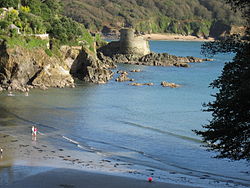Salcombe Castle
| Salcombe Castle | |
|
Devon | |
|---|---|
 Salcombe Castle | |
| Type: | Device fort |
| Location | |
| Grid reference: | SX733380 |
| Location: | 50°13’44"N, 3°46’35"W |
| Village: | Salcombe |
| History | |
| Key events: | Civil War seige |
| Information | |
| Condition: | Ruined |
Salcombe Castle or Fort Charles is a ruined fortification just off the beach of North Sands in Salcombe in Devon, overlooking the entrance to Salcombe Harbour and the Kingsbridge Estuary. The castle was built on a rocky outcrop which is easily reached on foot at low tide.
The caslt eruins are Grade II listed building and an ancient monument.[1][2]
The ruined structure includes a four-storey, semicircular tower of 24 feet with gun ports near the top. It is connected by a section of wall to a rectangular tower which is 20 feet high.[3]
History
The castle is thought to have been constructed originally during the reign of King Henry VIII, to defend the Kingsbridge estuary against French and Spanish pirates.[3]
The fort was strengthened in the 1640s on the orders of Prince Maurice.[2] It was the last place to hold out in the Royal cause against the victorious Parliamentarian troops of Oliver Cromwell in the Civil War. Sir Edmund Fortescue was ordered to hold it in 1643, when nearby Plymouth rose against the king; he rebuilt the castle at a cost of £135 6s 11d, and gave it the name "Fort Charles". [4][5] The castle was besieged from 15 January to 7 May 1646, and surrendered then only because it became clear that all other royalist strongholds had been overrun; the garrison were allowed to withdraw with their colours flying.[6] After the Civil War the castle was "slighted" (ruined) on the orders of Parliament as it was "too dangerous" to allow it to remain.[7]
In the 18th or 19th century a small watchtower was added.[3]
Pictures
-
Ruins taken from North Sands
-
Taken from a boat in the estuary
References
- ↑ National Heritage List 1289407: Salcombe Castle
- ↑ 2.0 2.1 National Heritage List 1020165: Fort Charles
- ↑ 3.0 3.1 3.2 "Fort Charles, Salcombe". Gatehouse. http://www.gatehouse-gazetteer.info/English%20sites/851.html. Retrieved 16 August 2016.
- ↑ Fortescue, Sir John; Clermont, Baron Thomas Fortescue (1869). The Works of Sir John Fortescue, Knight .... p. 32. https://books.google.com/books?id=J2gvAQAAMAAJ&pg=PA32. Retrieved 5 November 2012.
- ↑ Henning, Basil Duke (1983). The House of Commons, 1660-1690: Members C-L. Boydell & Brewer. p. 348. ISBN 978-0-436-19274-6. https://books.google.com/books?id=HW1_upECKUwC&pg=RA1-PA348. Retrieved 5 November 2012.
- ↑ Hawkins, Abraham (1819). Kingsbridge and Salcombe, with intermediate estuary, historically and topographically depicted. D. Southwood. p. 94. https://books.google.com/books?id=tqgwAAAAYAAJ&pg=PA94. Retrieved 5 November 2012.
- ↑ National Monuments Record: No. 444277 – Salcombe Castle

